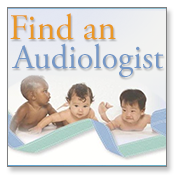Treatment and Intervention Services

No single treatment or intervention is the answer for every child or family. Good intervention plans will include close monitoring, follow-ups and any changes needed along the way. There are many different options for children with hearing loss and their families.
Some of the treatment and intervention options include:
- Working with a professional (or team) who can help a child and family learn to communicate.
- Getting a hearing device, such as a hearing aid.
- Joining support groups.
- Taking advantage of other resources available to children with a hearing loss and their families.
Early Intervention and Special Education
Early Intervention (0-3 years)
Hearing loss can affect a child’s ability to develop speech, language, and social skills. The earlier a child who is deaf or hard-of-hearing starts getting services, the more likely the child’s speech, language, and social skills will reach their full potential.
Early intervention program services help young children with hearing loss learn language skills and other important skills. Research shows that early intervention services can greatly improve a child’s development.
Babies that are diagnosed with hearing loss should begin to get intervention services as soon as possible, but no later than 6 months of age.
There are many services available through the Individuals with Disabilities Education Improvement Act 2004 (IDEA 2004). Services for children from birth through 36 months of age are called Early Intervention or Part C services. Even if your child has not been diagnosed with a hearing loss, he or she may be eligible for early intervention treatment services. The IDEA 2004 says that children under the age of 3 years (36 months) who are at risk of having developmental delays may be eligible for services. These services are provided through an early intervention system in your state. Through this system, you can ask for an evaluation.
Special Education (3-22 years)
Special education is instruction specifically designed to address the educational and related developmental needs of older children with disabilities, or those who are experiencing developmental delays. Services for these children are provided through the public school system. These services are available through the Individuals with Disabilities Education Improvement Act 2004 (IDEA 2004), Part B.
Early Hearing Detection and Intervention (EHDI) Program
Every state has an Early Hearing Detection and Intervention (EHDI) program. EHDI works to identify infants and children with hearing loss. EHDI also promotes timely follow-up testing and services or interventions for any family whose child has a hearing loss. If your child has a hearing loss or if you have any concerns about your child’s hearing, call toll free 1-800-CDC-INFO or contact your local EHDI Program coordinator to find available services in your state.
Technology
Many people who are deaf or hard-of-hearing have some hearing. The amount of hearing a deaf or hard-of-hearing person has is called "residual hearing". Technology does not "cure" hearing loss, but may help a child with hearing loss to make the most of their residual hearing. For those parents who choose to have their child use technology, there are many options, including:
- Hearing aids
- Cochlear implants
- Bone-anchored hearing aids
- Other assistive devices
Hearing Aids

Hearing aids make sounds louder. They can be worn by people of any age, including infants. Babies with hearing loss may understand sounds better using hearing aids. This may give them the chance to learn speech skills at a young age.
There are many styles of hearing aids. They can help many types of hearing losses. A young child is usually fitted with behind-the-ear style hearing aids because they are better suited to growing ears.
Cochlear Implants
A cochlear implant may help many children with severe to profound hearing loss — even very young children. It gives that child a way to hear when a hearing aid is not enough. Unlike a hearing aid, cochlear implants do not make sounds louder. A cochlear implant sends sound signals directly to the hearing nerve.
A cochlear implant has two main parts — the parts that are placed inside the ear during surgery, and the parts that are worn outside the ear after surgery. The parts outside the ear send sounds to the parts inside the ear.
CDC and the Food and Drug Administration (FDA) carried out studies in 2002 and 2006 to learn more about a possible link between cochlear implants and bacterial meningitis in children with cochlear implants. Read about the bacterial meningitis studies »
Bone-Anchored Hearing Aids
This type of hearing aid can be considered when a child has either a conductive, mixed or unilateral hearing loss and is specifically suitable for children who cannot otherwise wear 'in the ear' or 'behind the ear' hearing aids.
Other Assistive Devices
Besides hearing aids, there are other devices that help people with hearing loss. Following are some examples of other assistive devices:
- FM System
An FM system is a kind of device that helps people with hearing loss hear in background noise. FM stands for frequency modulation. It is the same type of signal used for radios. FM systems send sound from a microphone used by someone speaking to a person wearing the receiver. This system is sometimes used with hearing aids. An extra piece is attached to the hearing aid that works with the FM system.
- Captioning
Many television programs, videos, and DVDs are captioned. Television sets made after 1993 are made to show the captioning. You don't have to buy anything special. Captions show the conversation spoken in soundtrack of a program on the bottom of the television screen.
- Other devices
There are many other devices available for children with hearing loss. Some of these include:- Text messaging
- Telephone amplifiers
- Flashing and vibrating alarms
- Audio loop systems
- Infrared listening devices
- Portable sound amplifiers
- TTY (Text Telephone or teletypewriter)
Medical and Surgical
Medications or surgery may also help make the most of a person’s hearing. This is especially true for a conductive hearing loss, or one that involves a part of the outer or middle ear that is not working in the usual way.

One type of conductive hearing loss can be caused by a chronic ear infection. A chronic ear infection is a build-up of fluid behind the eardrum in the middle ear space. Most ear infections are managed with medication or careful monitoring. Infections that don't go away with medication can be treated with a simple surgery that involves putting a tiny tube into the eardrum to drain the fluid out.
Another type of conductive hearing loss is caused by either the outer and or middle ear not forming correctly while the baby was growing in the mother's womb. Both the outer and middle ear need to work together in order for sound to be sent correctly to the inner ear. If any of these parts did not form correctly, there might be a hearing loss in that ear. This problem may be improved and perhaps even corrected with surgery. An ear, nose, and throat doctor (otolaryngologist) is the health care professional who usually takes care of this problem.
Placing a cochlear implant or bone-anchored hearing aid will also require a surgery.
Learning Language
Without extra help, children with hearing loss have problems learning language. These children can then be at risk for other delays. Families who have children with hearing loss often need to change their communication habits or learn special skills (such as sign language) to help their children learn language. These skills can be used together with hearing aids, cochlear implants, and other devices that help children hear.
Read about learning language »
Family Support Services
For many parents, their child’s hearing loss is unexpected. Parents sometimes need time and support to adapt to the child’s hearing loss.
Parents of children with recently identified hearing loss can seek different kinds of support. Support is anything that helps a family and may include advice, information, having the chance to get to know other parents that have a child with hearing loss, locating a deaf mentor, finding childcare or transportation, giving parents time for personal relaxation or just a supportive listener.
- Page last reviewed: February 18, 2015
- Page last updated: February 18, 2015
- Content source:



 ShareCompartir
ShareCompartir